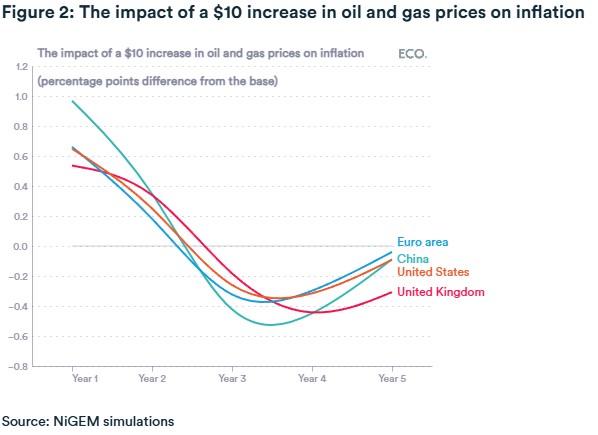Energy & Economics
How might a wider Middle East conflict affect the global economy?

Image Source : Shutterstock
Subscribe to our weekly newsletters for free
If you want to subscribe to World & New World Newsletter, please enter
your e-mail
Energy & Economics

Image Source : Shutterstock
First Published in: Oct.24,2024
Nov.18, 2024
The world economy is underperforming as a result of tight monetary policies, weaker global trade, a slowing Chinese economy and uncertainty around the US election. An escalation of conflict in the Middle East could increase uncertainties, harming inflation reduction efforts and hurting growth.
It has been over a year since the Hamas-led attack on Israel. Israel’s response in Gaza has resulted in widespread destruction and significant loss of life. The conflict has since expanded beyond Gaza, involving the Houthis in Yemen, Hezbollah in Lebanon and Iranian strikes targeting Israel.
In addition to the awful humanitarian cost of the conflicts, the war and the possibility of its further expansion pose significant repercussions for the global economy. This article discusses three potential ways in which the current conflict and a wider conflict in the Middle East could affect the global economy.
Increased geopolitical uncertainties
First and foremost, an escalation of the Middle East conflict could lead to greater geopolitical uncertainties. Figure 1 shows the evolution of the geopolitical risk (GPR) and geopolitical acts (GPRA) indices (Caldara and Iacoviello, 2022) – these are text-based measures of heightened uncertainties due to adverse geopolitical events such as wars, terrorism and international tensions. (See this article for more discussion about these measures.)
Following the Hamas-led attack on 7 October 2023, both the overall GPR index and its ‘war and terror acts’ component spiked strongly, to a level higher than that seen during the ISIS attack in Paris in November 2015.
Both indices eased significantly in the months following October 2023 despite the continuation of the conflict. But they jumped again following Israel’s attack on southern Lebanon in September 2024. As of mid-October 2024, the GPR and GPRA remain, respectively, 21% and 35% higher than their historical averages.

What might be the consequences of such elevated levels of risk? Research tells us that higher geopolitical risk raises oil prices (Mignon and Saadaoui, 2024). It also reduces global investment and increases inflation (Caldara et al, 2022).
Greater geopolitical risk has a significantly negative impact on business and consumer confidence in several advanced economies (de Wet, 2023). This is because consumers typically cut non-essential spending and businesses postpone investment decisions during turbulent times.
This reduces firm-level investment, particularly for businesses with higher initial investment costs and greater market power (Wang et al, 2023). Higher geopolitical risks also reduce global trade and financial flows, causing greater volatility in capital flows in emerging markets (Kaya and Erden, 2023).
Oil production cuts and higher energy prices
The second way in which the Middle East conflict could affect the global economy is its impact on energy prices, both directly through production cuts and indirectly through greater uncertainties.
In response to Israel’s actions against its neighbours, the Organization of the Petroleum Exporting Countries (OPEC) could reduce oil production to penalise countries supporting Israel. A similar action in the 1970s led to a significant jump in oil prices, which contributed to years of stagflation, with higher global inflation and recessions in major economies.
Before Israel's attack on Lebanon at the end of September, oil prices had been declining due to falling demand, particularly from China. On the supply side, oil production had increased in Canada and the United States, countering the production cuts by OPEC, and Saudi Arabia was expected to increase oil production from December.
But the situation quickly reversed following Israel’s attack on Lebanon. Oil prices jumped by nearly $10 per barrel within a week, before easing by around $5 per barrel. While the immediate oil price impact of Israel’s attack has mostly faded, the potential for higher oil (and other energy) prices still poses a risk to global inflation and economic activity (Liadze et al, 2022).
To provide further context for the potential scale of this impact, we can show what would happen if oil and gas prices were to remain $10 higher for two years than the baseline levels projected in the Summer Global Economic Outlook from the National Institute of Economic and Social Research (NIESR), using NIESR’s Global Macroeconometric Model (NiGEM).
The results demonstrate that the $10 rise in oil and gas prices increases inflation by around 0.7 percentage points in major economies in the first year (see Figure 2). The impact is higher in China, where the economy relies relatively more on oil imports for its strong manufacturing industries. The inflationary pressures persist for two years despite central banks’ efforts to curb inflation by increasing interest rates.

The effect of higher oil and gas prices on real GDP is shown in Figure 3. In the scenario described above, GDP would fall by 0.1-0.2% in major economies immediately. Partly due to higher interest rates, real GDP would continue to weaken for three years following the shock. After this, economic activity would start to return to base levels as oil and gas prices revert to their levels in the baseline forecast.

Increased shipping costs and supply chain disruptions
A wider conflict in the Middle East could also affect the economy through higher shipping costs and supply chain disruptions. Houthi attacks on commercial ships in the Red Sea in late 2023 showed that such disruptions can have a huge impact on global trade through shipping, which comprises 80% of world trade volume.
Following the rocket attacks by the Houthi rebels, some commercial shipping re-routed from the Red Sea to the Cape of Good Hope, leading to significant delays in travel times and increased freight costs. As a result, the Shanghai Containerized Freight Index – a measure of sea freight rates – rose by around 260% in the second quarter of 2024 with additional disruptions to supply chains.
Our analysis shows that an increase of 10 percentage points in shipping cost inflation can lead to import prices rising by up to around 1% and consumer inflation increasing by around 0.5% in OECD countries.
As Figure 4 shows, the impact of shipping costs on inflation shows its full effects over six quarters. This means that inflationary concerns could be with us for the next year and a half as a result of higher shipping costs that may emerge from any possible escalation of the Middle East conflict.

Wider economic implications and policy responses
While rising geopolitical risk and increased oil and shipping costs can each individually exert upward pressure on inflation and may slow down economic activity in the global economy, the combined impacts are likely to be greater.
Countries with stronger trade and financial ties to the Middle East and those that rely heavily on oil imports as an input for domestic production would be most affected.
On the monetary policy front, central banks may have to take a more hawkish stance in response to rising inflationary pressures from the Middle East conflict. This could lead to higher interest rates, which would further dampen economic activity, particularly in an environment where there are already recessionary concerns in some major economies.
Beyond its immediate economic implications, an escalation of the Middle East conflict could trigger large-scale displacement of people, which would increase economic and social pressures on neighbouring countries. Many countries may also have to increase their military spending in response to growing regional tensions.
Given that public debt levels are already elevated in many countries due to successive shocks to the global economy over the past decade, any additional defence spending could come at the expense of public infrastructure investments that would otherwise boost productivity growth.
Overall, the global economy is already underperforming as a result of the lagged effects of tight monetary policies, weaker global trade, a slowing Chinese economy and uncertainties surrounding the upcoming US election and possible changes to US trade policy.
A potential escalation of conflict in the Middle East could exacerbate the situation by increasing uncertainties, harming efforts to bring down inflation and reducing global GDP growth.
Over the medium and long term, it could further damage the global economy, with the possibility of refugee crises as well as increased defence spending, making the effects more complex and longer lasting.
This work is licensed under a Creative Commons Attribution-ShareAlike 4.0 International License.
First published in :

Ahmet is a Principal Economist at NIESR. He holds an MSc from the University of Groningen and a PhD from Hacettepe University. Before joining NIESR, Ahmet worked as an economist at the British Embassy in Turkey and the Turkish Treasury. He also held research roles at the Groningen Growth and Development Centre (GGDC) and UNU-WIDER. Ahmet’s research focuses on international trade and finance, capital flows, structural transformation, and productivity growth in developing countries.
Unlock articles by signing up or logging in.
Become a member for unrestricted reading!